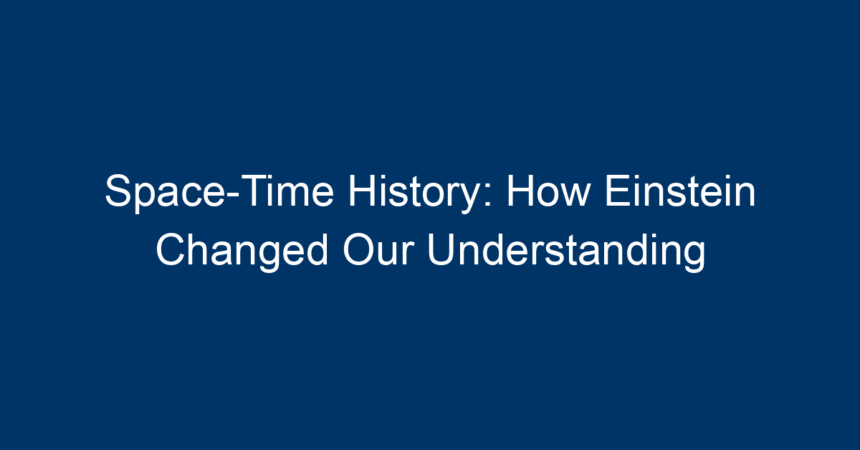Introduction
In the realm of physics, few concepts have been as transformative as the idea of space-time. This revolutionary framework proposed by Albert Einstein not only altered our understanding of the universe but also redefined fundamental principles of time and space. In this article, we will explore the evolution of space-time history, delve into Einstein’s groundbreaking theories, and discuss how these ideas continue to influence physics, cosmology, and our everyday experiences.
What Is Space-Time?
Before diving into the contributions of Einstein, it’s essential to grasp the notion of space-time itself. Traditionally, space and time were viewed as separate entities. However, as early as the 19th century, scientists began to hint at a relationship between the two.
The Traditional View
In classical physics, space was considered a three-dimensional grid where objects existed, while time flowed uniformly in a linear fashion. This Newtonian paradigm dominated scientific thought until the early 20th century.
The Einstein Revolution
Einstein’s special theory of relativity (1905) merged space and time into a single four-dimensional continuum known as space-time. This radical shift posed a question: What happens to our understanding of physics when we treat space and time as interconnected?
The Special Theory of Relativity
Einstein’s special theory of relativity introduced two key principles:
1. The Constancy of the Speed of Light
One of the most transformative ideas in space-time history is that the speed of light in a vacuum remains constant, irrespective of the motion of the observer or the light source. This principle leads to astonishing implications, including time dilation and length contraction.
2. Time Dilation and Length Contraction
Imagine traveling in a spaceship at a speed approaching that of light. According to Einstein, time would pass slower for you than for someone remaining on Earth. This phenomenon, known as time dilation, changes our perception of time as something relative rather than absolute.
Example: If you traveled at near-light speeds for what felt like a few weeks, you might return to Earth only to find that many years have passed. This effect highlights the elastic nature of time within the framework of space-time.
The General Theory of Relativity
Einstein expanded his ideas in 1915 with the general theory of relativity, further cementing his legacy in space-time history. This theory addressed gravity’s role within the space-time continuum.
Curvature of Space-Time
Einstein proposed that massive objects like stars and planets warp the space-time around them, creating what we perceive as gravity. Rather than viewing gravity as a force pulling objects towards one another, it is more accurate to see it as the curvature of the space-time fabric.
The Effects of Curvature
The curvature caused by objects not only affects the trajectory of other celestial bodies but also influences the passage of time. For example, clocks situated closer to a massive body will tick slower compared to those farther away.
Space-Time in Modern Physics
Einstein’s theories have laid the groundwork for several advancements in modern physics. Understanding space-time history is crucial not only for theoretical research but also for practical applications.
From Black Holes to the Big Bang
The implications of general relativity extend to some of the most fascinating phenomena in the universe:
-
Black Holes: Formed from the remnants of massive stars, black holes represent regions of space where gravity is so strong that nothing can escape—not even light. Their existence reinforces the dynamic nature of space-time, altering how we view the universe.
- The Big Bang Theory: The notion that our universe originated from an infinitely dense point connects directly to ideas of space-time evolution. The expansion of space-time is a critical aspect of cosmological studies, impacting theories about the universe’s fate.
GPS Technology and Space-Time
Einstein’s theories have tangible applications in modern technology. Global Positioning System (GPS) satellites rely on accurate measurements of time to function correctly. Due to the effects of both special and general relativity, engineers must account for time dilation to ensure precise positioning data.
The Impact of Einstein’s Legacy on Science and Philosophy
Einstein’s theories have not just reshaped physics but have also influenced philosophy, art, and culture. The idea that time can be perceived differently depending on one’s relative speed or gravitational field challenges our fundamental understanding of reality.
Philosophical Implications
The interconnection of space and time invites philosophical discussions about determinism, free will, and the nature of reality. Are historical events fixed, or can they be altered by choices made in the present? This ongoing discourse illustrates how space-time history transcends disciplinary boundaries.
Cultural Impact
Einstein’s contributions have permeated popular culture through literature, films, and art. Works like "Interstellar" delve into the intricacies of time travel and black holes, stimulating public interest in complex scientific concepts.
Conclusion: Embracing Space-Time History in Contemporary Life
Einstein’s revolutionary ideas regarding space-time continue to inspire scientific inquiry and philosophical contemplation. By understanding the transformative nature of space-time history, we can appreciate the complexities of the universe and the intricate relationship between time and space.
Actionable Insights
- Explore Further: Delve into books and documentaries about Einstein’s life and discoveries to deepen your understanding of space-time.
- Engage with Technology: Utilize apps and devices that require knowledge of relativity, such as GPS, to see how these principles operate in real life.
- Encourage Discussion: Spark conversations about the implications of space-time with friends and family, fostering a deeper appreciation for science in daily life.
By embracing and exploring the phenomena of space-time, we honor Einstein’s legacy while expanding our understanding of the universe and our place within it.




